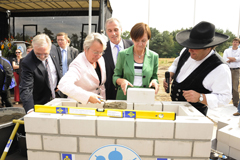Federal Research Minister Professor Annette Schavan, Hamburg’s Science Senator Dr. Herlind Gundelach and Schleswig-Holstein’s Research Minister Dr. Jörn Biel laid the cornerstone for the accelerator module test facility (AMTF hall) at DESY.

Schavan, Gundelach and Biel lay cornerstone at DESY
On 21 July, Federal Research Minister Professor Annette Schavan, Hamburg’s Science Senator Dr. Herlind Gundelach and Schleswig-Holstein’s Research Minister Dr. Jörn Biel met at the research centre DESY in Hamburg to sign an agreement for the participation in the European XFEL X-ray facility. With 90 million Euros, the federal states Hamburg and Schleswig-Holstein will cover nearly 16 percent of Germany’s contribution to the European XFEL. The three politicians also laid the cornerstone for the accelerator module test facility (AMTF hall) and symbolically “cement” this considerable investment in research. As of 2011 superconducting accelerator modules will be submitted to intense functional tests at -271 degrees centigrade in the hall. After these tests the twelve-metre-long modules weighing 10 tons will be transferred to the main tunnel of the X-ray facility to be assembled into a 1.7-kilometre-long electron accelerator.
The 3.4-kilometre European X-ray laser facility runs from the DESY site in Hamburg-Bahrenfeld to the town of Schenefeld in Schleswig-Holstein. It will generate ultrashort pulses of X-ray light – 30 000 times per second and with a light intensity a billion times higher than the best conventional X-ray radiation sources. For this purpose, bunches of electrons are first accelerated to high energies and then directed through long arrays of magnets in which they emit X-ray laser flashes. With its superconducting accelerator, the facility has unique characteristics that will open up completely new research opportunities for scientists and industrial users.
The Helmholtz research centre DESY is the leader of the international consortium for the construction of the accelerator, the “heart” of the research facility. The components of the accelerator modules – the cavities – are industrially produced in several countries and assembled into the twelve-metre modules in France. As of 2011, the new DESY hall will be used to test the technical properties of both the more than 800 accelerating cavities and a total of 101 European XFEL accelerator modules before they are built into the accelerator. The tests are running at an operating temperature of -271 degrees centigrade under real operating conditions. The accelerator units must be produced to highest standards. Particles are accelerated in the cavities with very strong electromagnetic fields. Any bumps or impurities on the surface of the superconducting cavities made of the metal niobium would cause a breakdown of the accelerating field, meaning that the X-ray laser facility would not be able to function properly.
The construction costs of the European XFEL facility amount to 1.08 billion Euros (price levels of 2005). It will be carried out as an international project. Alongside Germany, twelve European countries and China are participating in the facility. The total German contribution to the construction costs amount to 580 million Euros (price levels of 2005), the rest is funded by the participating countries. The establishment of an independent research centre for the construction and operation of the new X-ray facility – the European XFEL GmbH, a limited liability company – is scheduled for this year. The research campus that will be home to about 300 people from the year 2015, is located in the town of Schenefeld in the Pinneberg district of Schleswig-Holstein.
(from: DESY press release)





